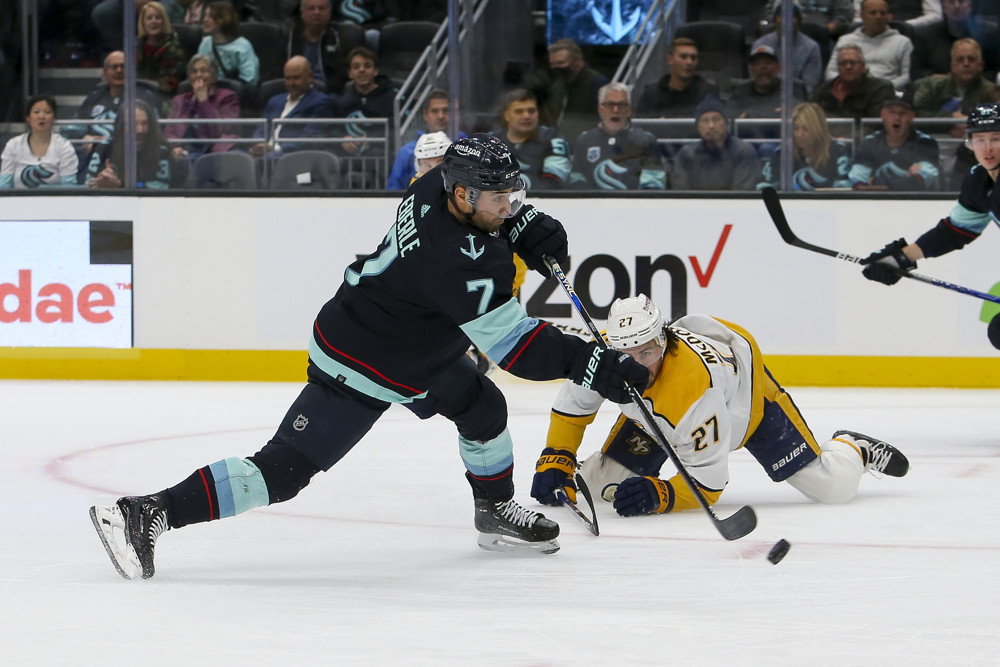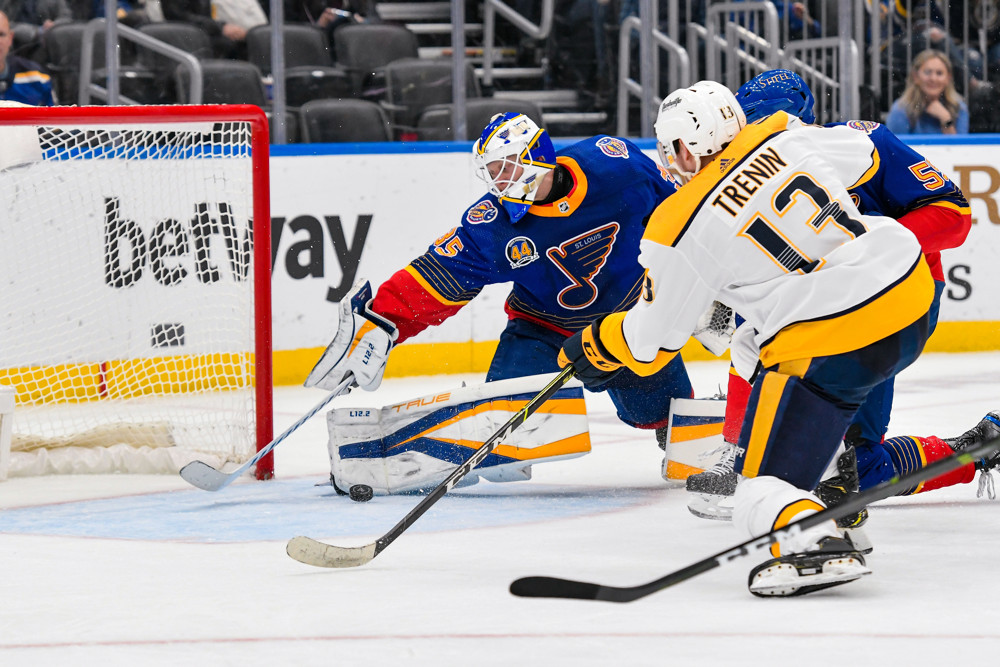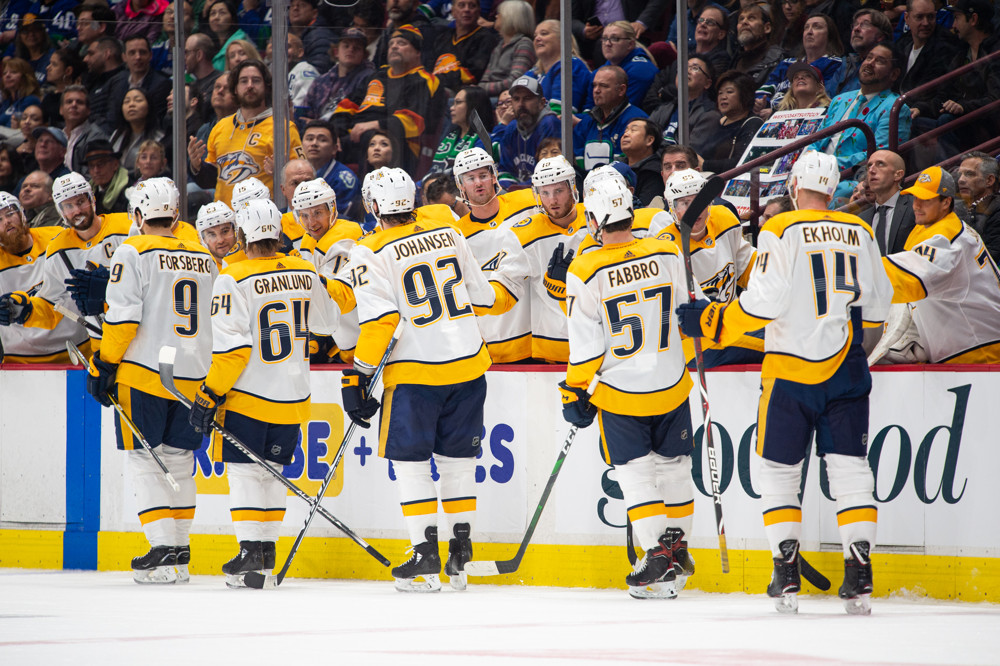
Okay, let’s wind the clocks back to December 29th. Nashville grabbed a 3-2 lead in the second period over the New York Rangers, then caved in the third. Predator Facebook and Twitter were in a state of utter confusion and panic, claiming the team wasn’t making the playoffs and talks of trade were inevitable.

The team responded with a win over Washington on New Year’s Eve, then shutout the Flyers at home the very next day. Praises and cheers rained down from the rafters, Facebook and Twitter criticisms were quiet- you’d think the six game losing streak never happened.
Let’s take a look at the little issues they have, the rather larger issues they have, and also alleviate your concerns if possible.
Minor Complications
In all honesty, only two minute problems stand out to me; they are more annoying than anything, but are definitely worth mentioning.

Nashville succeeds on the power play 15.1% of the time, good for 24th in the league. They’ve netted only one five on three goal this year, courteous to Viktor Arvidsson. Recently, they switched up their formation and started parking bodies in front of the net; because of that, Nashville has converted three times in the last three games. Nashville’s penalty kill dramatically improved when Austin Watson returned- they comfortably sit at 6th in the league with an 81.1% success rate.
Nashville’s special teams have been a problem since the first game, so why worry about it now? Any success is success, and the penalty kill is right where it was last year. They dominate at five on five, and occasionally snag a power play goal.

Roman Josi leads the team in shots with 148. That’s not really an issue except it alludes to another issue: the forwards aren’t generating enough offense in the dirty areas. Another unique part of this stat- he’s outshot both Ryan Ellis and Mattias Ekholm combined. It’s not a problem because Josi has produced 29 points- if the numbers are there, who’s to complain?
Basically, their special teams are average to below average, and the forwards aren’t shooting enough. Annoying, but not devastating.
A Big Reason They Weren’t Doing Well
In November, Juuse Saros went into a major slump, and Pekka Rinne could not get any goal support. Neither of them produced a shutout for almost two months, and it just so happened that those two months were exactly when Nashville needed one.

Saros started three games in November, and allowed a minimum of four goals in each. He surrendered 19 goals on 105 shots between November 10th and December 8th. The worst performance was against St. Louis, as he allowed five on fifteen shots, and was pulled in the second period. Since December 15th, he’s been back to his old ways. Of the 78 shots he’s seen, he’s turned away 76 shots. His shutout against Philadelphia was arguably his best performance of his career.
Rinne has done nothing out of the ordinary; he’s kept Nashville in games where maybe the team didn’t necessarily deserve to win. He allowed four goals on only three occasions in two months.
Goal support for both goaltenders would have been nice to have, but ultimately, Rinne did what he was supposed to do. Saros fell off the charts, but has rebounded beautifully. They’re right where they need to be going into the second half of the season.
Another Big Problem (Sort Of)

The first line is supposed to push the offense, but the second line shares responsibility for production as well. Last year, Nashville’s second line was a force to be reckoned with. Through 41 games this year, it’s been a subtly different story this year, but the difference has stung.
Kevin Fiala and Craig Smith combined for 51 points in 41 games last year, whereas Nick Bonino and Colton Sissons only produced 19 points. This year, Fiala and Smith have combined for 43 points, while Bonino and Sissons have produced 33 points. The eight point differential between Fiala and Smith’s stats last year and this year had unintended consequences: Nashville lost four one-point games in November, and three one-point games in December.
One might argue that player production can vary year to year, but it’s different this time: Nashville hasn’t been healthy all year, and two 20 goal scorers didn’t perform when the team needed them to. The bottom six have done more than what they’ve been assigned to do, but it wasn’t enough.
I know this doesn’t seem like a problem, but it’s concerning when one looks at where these forwards start.
Bonino’s offensive zone start percentage in all scenarios rounds out to 31%. Sissons is slightly better- he’s started in the offensive zone 33.1% in all scenarios. Fiala starts in the offensive zone 74%, and Smith starts in the offensive zone 72.9% of the time.
Given their place in the lineup and on where they start alone, Smith and Fiala are designed to score more than Bonino and Sissons, and it seems production has been relatively even between the four forwards.
Here are their Corsi For and High Danger Goal For percentages to reiterate that point.
Fiala: 54.16% (CF), 40.91% (HDGF)
Smith: 55.01% (CF), 50% (HDGF)
Sissons: 52.19% (CF), 77.78% (HDGF)
Bonino: 47.27% (CF), 75.00% (HDGF)
Fiala and Smith are seeing more total shot attempts for Nashville, yet Bonino and Sissons are capitalizing in front of the net more frequently and playing better defense. The point is the offensively inclined forwards performed partially better than the defensive oriented forwards.
Injuries have also taken its toll on Nashville.
Who’s been missing?
Nashville has been without the services of Viktor Arvidsson, Filip Forsberg, P.K. Subban, Kyle Turris, Colton Sissons, Calle Jarnkrok, Nick Bonino, Austin Watson, Yannick Weber and Mattias Ekholm for at least one game.

Ekholm and Bonino missed a game apiece due to illness. Watson served an eighteen game suspension to start the year. Jarnkrok missed a four game road trip in November. Subban was gone for 18 games with an undisclosed injury, and Arvidsson was sidelined for 21 games with a broken thumb after returning from a lower body injury.
Weber’s been hurt since the third period against Boston. Turris worked through an undisclosed injury for eight games, and is working through another one. Sissons has missed six games and counting. Forsberg hasn’t played since November 29th, adding up to thirteen games with more to come. It would be a massive understatement to say the injury bug has bit Nashville severely.
What Does The Future Hold?

If one were to ask why the Predators weren’t very successful in November and December, there are many things that could be pointed out. However, the best predictor of the future is the past, and if that’s the case, here’s where the Predators were two years ago, a year ago, and right now through 41 games.
2016/2017: 19-15-7, 45 points
2017/2018: 24-11-6, 54 points
2018/2019: 24-15-2, 50 points
So, they’re right around where they were last year (in which they won the President’s Trophy), and the year before that (in which they went to the SCF).
Two years ago, they were missing P.K. Subban, and a year ago, they were missing Ryan Ellis. This year, they’re missing Filip Forsberg.
What fans have seen for the past two months is simply what the team would look like without Forsberg, Arvidsson, and Subban for an extended period of time. They are apart of the Predators’ identity, and the team has suffered significantly in their absence.
Nashville has not played with their full squad once this year. At least one starter has been missing from the lineup every game (five starters were absent against their matchup against Chicago on December 1st). Once all their bodies are back, Nashville will be in good shape.
I’d also be remiss to mention they’re still second in the Central Division by only two points. Nashville’s resilience was rewarded against one of the best teams in the league, and now, they have momentum going into another long road trip.
It’s January, folks. They’re going to be fine.









